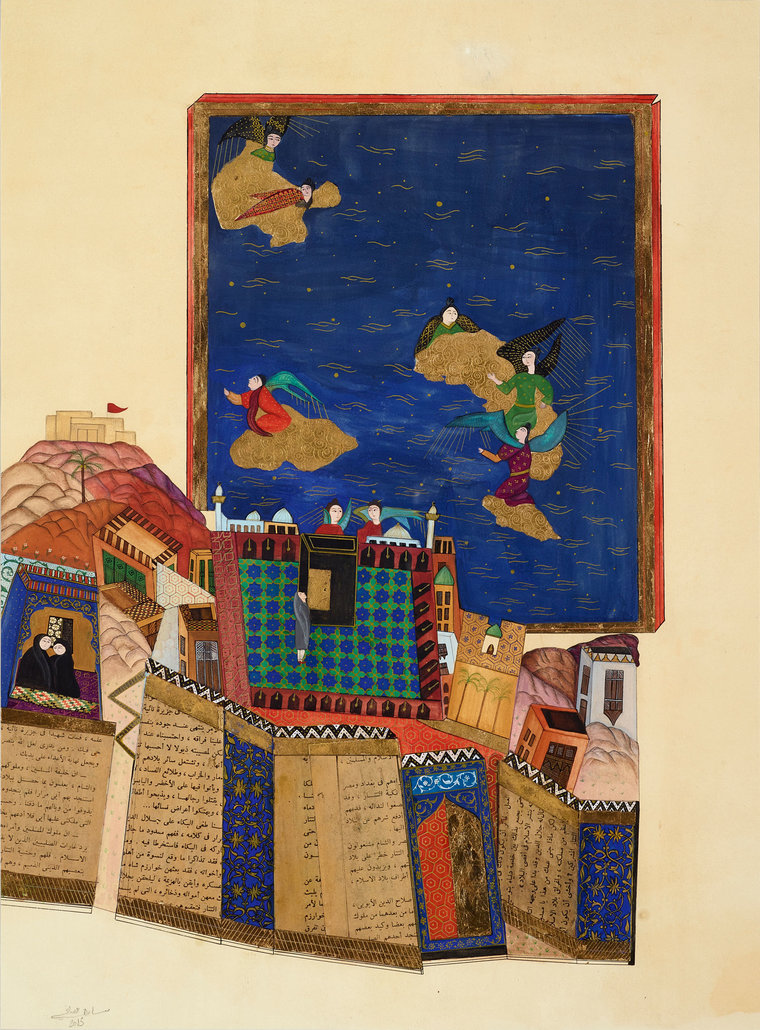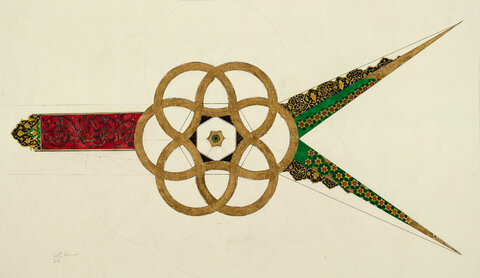Saudi Arabian artist Sarah Al Abdali, born in Jeddah in the historic Hejaz region, is known for her intricate compositions that merge miniature painting techniques with Hejazi cultural heritage and Islamic art traditions. In Makkah, 2015, she constructs a visual ascent by layering text, architecture, and celestial imagery to mirror the spiritual and physical dimensions of Mecca, the holiest city in Islam.
At the base, fragmented panels of Arabic manuscript cut-outs anchor the artwork. The text, framed in gold leaf, is arranged in irregular segments, creating a collage effect that disrupts the visual flow. This technique conveys the fragmented nature of contemporary narratives surrounding Mecca with regards to modernization. The text may allude to Quranic verses or other religious writings, grounding the work in a spiritual context.
Above the text, the composition transitions into a densely packed cityscape rendered in earthy tones of brown, beige, and terracotta. The architectural structures are distinctly Hejazi, featuring symmetrical facades, arched windows, and intricate geometric patterns. Among these structures, miniature female figures move through the city, depicted in long, flowing black and grey abayas and headscarves characteristic of traditional Hejazi attire.
The uppermost section presents a vivid blue rectangle framed by bright red borders, creating the illusion of a three-dimensional portal or elevated plane. Within this celestial expanse, winged ethereal figures float on golden clouds, adorned in flowing garments of red, magenta, and green. Their wings, intricately detailed with gold leaf, catch the light, reinforcing the spiritual tone of the scene. The use of raised, textured gold leaf not only connects the upper realm to the divine but also adds a tactile quality that guides the viewer’s eye from the city below to the spiritual plane above.
Throughout the composition, earthy tones and gold accents echo the natural palette of the Hejaz, further grounding the work in its geographical and cultural roots. Al Abdali’s choice of gouache, with its rich opacity, allows for precise, controlled lines that define her miniature and detailed architectural forms, while the gold leaf is applied using a technique akin to relief gilding, producing a raised surface that is both visually and physically prominent. This interplay between matte and reflective surfaces mirrors the juxtaposition of heaven and earth reflected in the holy city of Mecca.
Al Abdali’s work is deeply rooted in her connection to the Hejaz, a region known for its distinctive architecture and pivotal role in Islamic scholarship. By reimagining Mecca through the visual language of Hejazi ornamentation, Al Abdali bridges past and present, reflecting on how sacred spaces are preserved, redefined, and reimagined amidst modernization.






